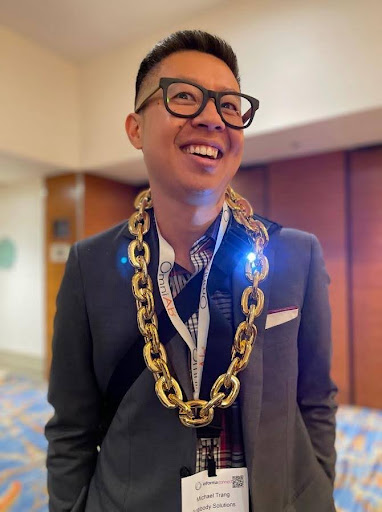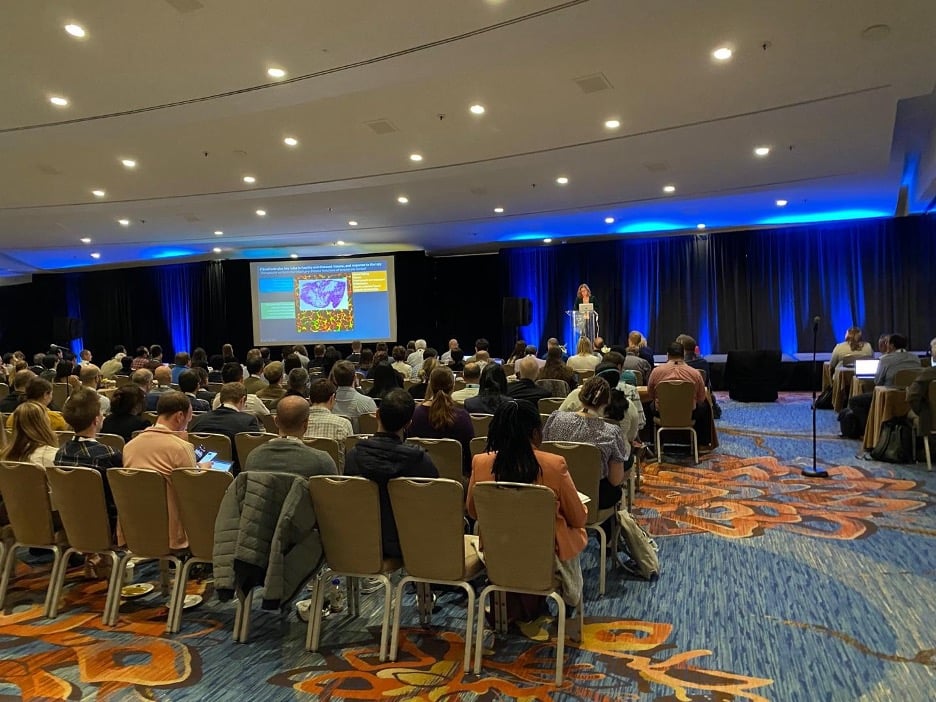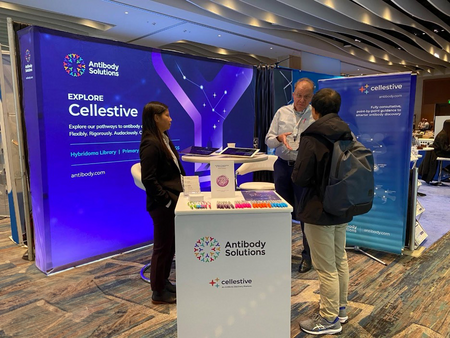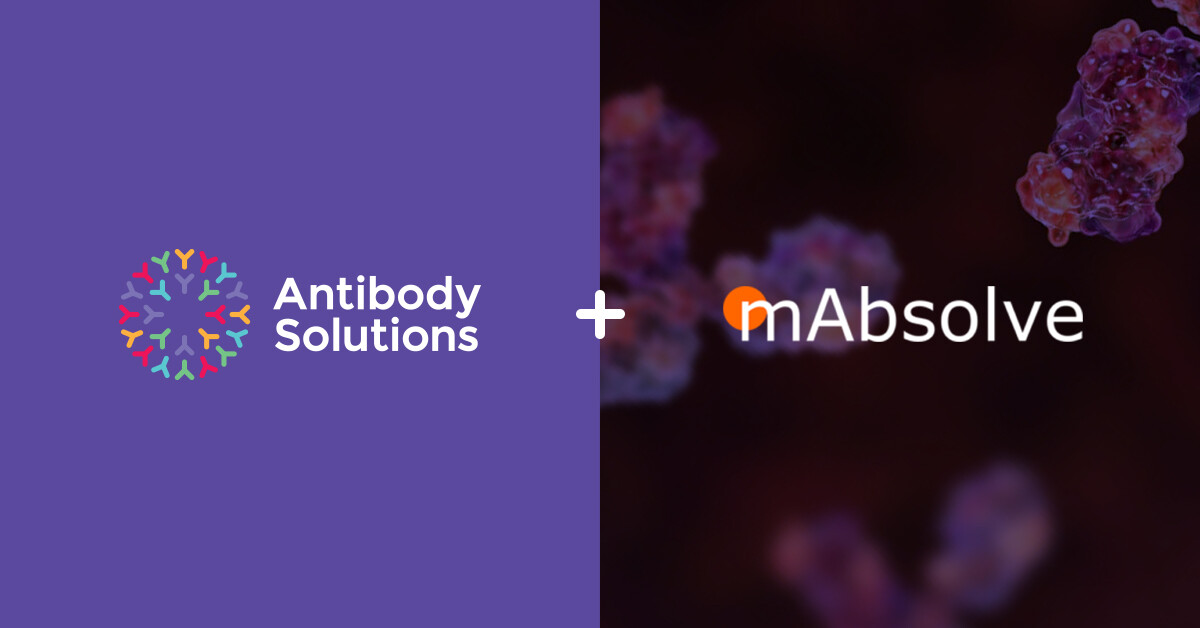5 min read
Antibody Engineering and Therapeutics 2023 Recap
By Dr. John Kenney on Feb 5, 2024 3:26:19 PM
Topics: Events Transgenic Animals

We were glad to squeeze in one more conference before last year came to a close: Antibody Engineering and Therapeutics (AET) 2023. AET is always a great chance to connect with friends and colleagues in the biotechnology sphere who we don’t get to see in person very often. This time, I was accompanied by Michael Trang and Jennifer Somera, two of Antibody Solutions’ esteemed project managers.
Jennifer Somera and John Kenney answer questions at the Antibody Solutions booth.
Will AI Kill the Lab?
I attended a pre-conference workshop on “The Promises and the Challenges of Machine Learning (ML) and Artificial Intelligence (AI) in Antibody Discovery.” With all the recent hype about ML/AI, the speakers at this workshop all sought to answer the same question: “How well can ML/AI replace traditional discovery?”
What is clear is that ML/AI is a fast-moving field driven by developments in data, hardware, algorithms, and models. Among models for 3D structure generation, diffusion models and large language models (LLM) are the most popular and generally considered the best performing. Diffusion models work by adding Gaussian noise to original data and then feeding the resulting dataset into a model, which the model then “learns” to remove the Gaussian noise selectively. This results in a clearer picture of the original data. RFdiffusion from the Institute for Protein Design is an example of a diffusion model for protein sequence generation against a target of interest. Large language models work by summarizing very large datasets to predict and generate structures. AlphaFold2, from Google’s DeepMind company, is an example of an LLM to generate protein structures. Large language models also include BioPhi, which can predict the humanness of an antibody and design a humanized antibody from, for example, a mouse antibody.
What is common to all is they are based upon existing structural data (e.g., x-ray crystallography, cryo-EM, and/or an existing antibody sequence) which means they can be: (a) fairly predictive of a structure if a similar structure is known; but also, (b) poor at predicting a novel structure that is not known. Thus, the ability to create, de novo, antibodies based upon ML/AI alone is still viewed as many years away. The bottom-line conclusion of the workshop was that ML and AI are tools that are complementary to, but will not replace, traditional discovery methods any time soon. To paraphrase one speakers’ comments: “The wet lab will always be with us.”
Accessing New Technologies
AET is an aptly named conference, with sessions running the gamut from discovery and engineering to therapeutics. On the discovery front, OmniAb and Alloy Therapeutics each introduced new animal models.
OmniAb described their newest human-antibody-producing transgenic chicken, OmnidAb, which produces human-heavy-chain-only antibodies. Heavy-chain-only antibodies are used in bispecific antibody combinations; the chicken offers a different immune repertoire compared to heavy-chain-only transgenic rodents. Alloy Therapeutics described their new ATX-GKH hyperimmune mouse which is a transgenic mouse that has enhanced serum titers and more antigen-specific b-cells than conventional Balb/c mice. Human-antibody-producing transgenic rodents have traditionally been found to have lower lymphocyte counts in spleen and lymph nodes compared to conventional mice. The ATX-GKH hyperimmune mouse appears to have overcome this limitation.

Michael and "heavy-chain" swag at the OmniAb launch party for the heavy-chain-only chicken, OmnidAb.
Therapeutic Horizons
On the therapeutic front, AET offered multiple sessions focused on therapeutic strategies: “Bispecifics and Therapeutic Combinations,” “Antibody-Based Cell Therapies,” and “Therapies in the Tumor Microenvironment.” In the last case, there has been considerable interest in the past few years on therapies that can modulate the tumor microenvironment (TME) (for a comprehensive review, see this link). Cells and secreted factors in the TME can be either tumor-suppressive or tumor-supporting. Furthermore, the TME is thought to play an essential role in regulating the effectiveness of therapeutic intervention with tumor-specific drugs. These observations support the use of a combination of drugs that target cells and/or secreted factors in the TME, in addition to the tumor itself.
The TME was the focus of the keynote talk delivered by Genentech’s Shannon Turley; of particular interest was the stromal cell niche that includes cancer-associated fibroblasts (CAFs). She described how TGFbeta-activated CAFs are the dominant fibroblast population in human pancreatic ductal adenocarcinoma (PDAC) and how they are associated with a lack of response to immunotherapy. She showed results where treatment with an anti-PDL-1 plus anti-TGFbeta mobilizes T-cells to go into the tumor where, without anti-TGFbeta, they stay on the periphery. Treatment with anti-TGFbeta converted an immune-excluded tumor into an inflamed tumor, followed by regression of the tumor in an animal model. Still, there is limited clinical data and more studies are needed to determine the effectiveness of therapies targeting stromal cells in the treatment of solid tumors.
 Shannon Turley describing the role of stromal niches in inflammation, cancer, and immunotherapy.
Shannon Turley describing the role of stromal niches in inflammation, cancer, and immunotherapy.
AET was a great opportunity to get immersed in subjects both familiar and unfamiliar. We’re looking forward to AET returning to its regular week-long schedule next year.
Drop me a line if you would like to discuss the latest antibody discovery technologies and trends. We’ve worked with countless targets for antibody discovery and welcome working with you to create candidates, whatever your therapeutic strategy.

Written by Dr. John Kenney
Author of more than 40 publications, John’s current research interests include new technologies for improving therapeutic antibody discovery, properties of next-generation antibody-like molecules, and best practices for critical reagents used in biologics development.
Filter by Keyword
- Insights (34)
- Events (16)
- COVID-19 (15)
- SARS-CoV-2 (14)
- News (11)
- Molecular Modeling (9)
- Transgenic Animals (6)
- Antibody Discovery (4)
- Therapeutic Targets (3)
- 25th Anniversary (2)
- Omicron (2)
- Therapeutic Monoclonal Antibodies (2)
- Antibody Generation (1)
- Antibody-Drug Conjugate (ADC) (1)
- Antigen (1)
- CAR-T (1)
- Cell Fusion (1)
- Cell therapy (1)
- Functional Assays (1)
- Harbour (1)
- Hybridoma (1)
- IgG purification (1)
- Immunoassays (1)
- Immunogens (1)
- Lambda Light Chain (1)
- Lambda Mouse (1)
- MAbExpress (1)
- Monoclonal (1)
- OmniRat (1)
- Peptides (1)
- Syngeneic (1)
- Target Analysis (1)
- Transgenic H2L2 Mice (1)
- Women In Bio (1)
- igG (1)
- mRNA (1)




